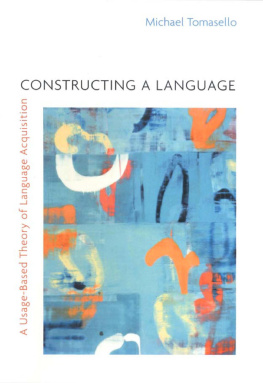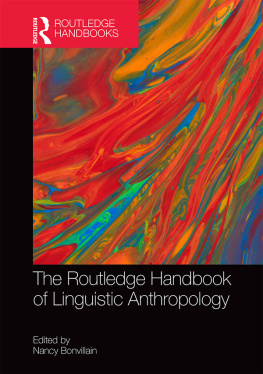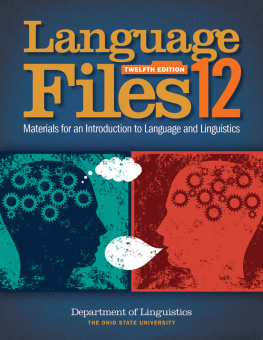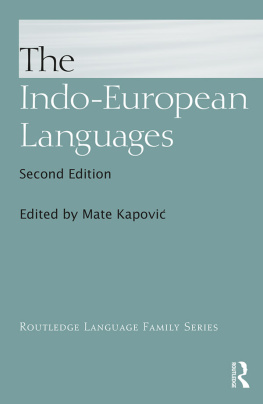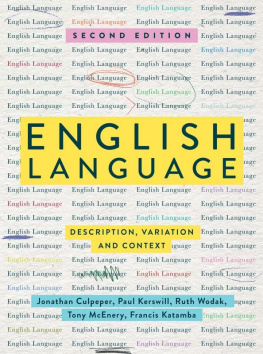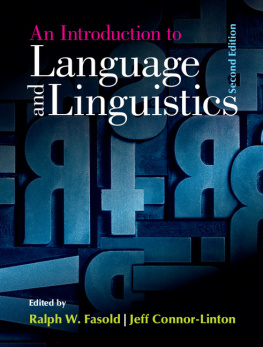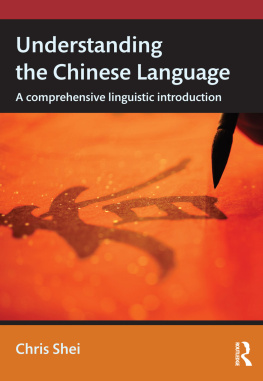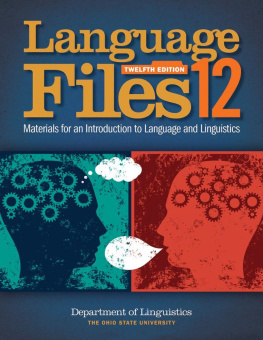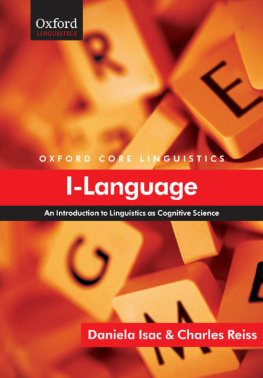This page intentionally left blank
Linguistics
Written by a team based at one of the worlds leading centres for linguistic teaching and research, the second edition of this highly successful textbook offers a unified approach to language, viewed from a range of perspectives
essential for students understanding of the subject. A language is a com-
plex structure represented in the minds of its speakers, and this textbook
provides the tools necessary for understanding this structure. Using clear
explanations throughout, the book is divided into three main parts: sounds,
words and sentences. In each, the foundational concepts are introduced,
along with their application to the fields of child language acquisition,
psycholinguistics, language disorders and sociolinguistics, giving the book
a unique yet simple structure that helps students to engage with the subject more easily than other textbooks on the market. This edition includes a
completely new section on sentence use, including an introduction and
discussion of core areas of pragmatics and conversational analysis; new
coverage of sociolinguistic topics, introducing communities of practice; a
new subsection introducing the student to Optimality Theory; a wealth of
new exercise material and updated further reading.
andrew radford, martin atkinson, david britain, harald
clahsen and andrew spencer all teach in the Department of Language
and Linguistics at the University of Essex.
Linguistics
An Introduction
SECOND EDITION
A N D R E W R A D F O R D
M A RT I N AT K I N S O N
D AV I D B R I TA I N
H A R A L D C L A H S E N
and
A N D R E W S P E N C E R
University of Essex
CAMBRIDGE UNIVERSITY PRESS
Cambridge, New York, Melbourne, Madrid, Cape Town, Singapore, So Paulo
Cambridge University Press
The Edinburgh Building, Cambridge CB2 8RU, UK
Published in the United States of America by Cambridge University Press, New York
www.cambridge.org
Information on this title: www.cambridge.org/9780521849487
Andrew Radford, Martin Atkinson, David Britain, Harald Clahsen and Andrew
Spencer 2009
This publication is in copyright. Subject to statutory exception and to the
provision of relevant collective licensing agreements, no reproduction of any part may take place without the written permission of Cambridge University Press.
First published in print format 2009
ISBN-13 978-0-511-47924-3
eBook (EBL)
ISBN-13 978-0-521-84948-7
hardback
ISBN-13 978-0-521-61478-8
paperback
Cambridge University Press has no responsibility for the persistence or accuracy of urls for external or third-party internet websites referred to in this publication, and does not guarantee that any content on such websites is, or will remain, accurate or appropriate.
Contents
List of illustrations page x
List of tables
xii
Preface to the second edition
xiii
A note for course organisers and class teachers
xiv
Introduction
1
Linguistics
2
Developmental linguistics
6
Psycholinguistics
9
Neurolinguistics
11
Sociolinguistics
14
Exercises
17
Further reading and references
21
Part I Sounds
23
1 Introduction
25
2 Sounds and suprasegmentals
27
Consonants
28
Vowels
36
Suprasegmentals
41
Exercises
44
3 Sound variation
47
Linguistic variables and sociological variables
47
Stylistic variation
53
Linguistically determined variation
54
Variation and language change
56
Exercises
59
4 Sound change
61
Consonant change
61
Vowel change
64
The transition problem: regular sound change versus lexical
diffusion
67
Suprasegmental change
70
Exercises
72
v
vi
Contents
5 Phonemes, syllables and phonological processes
75
Phonemes
75
Syllables
78
Syllabification and the Maximal Onset Principle
81
Phonological processes
82
Phonological features
85
Features and processes
86
Constraints in phonology
90
Exercises
92
6 Child phonology
96
Early achievements
96
Phonological processes in acquisition
97
Perception, production and a dual-lexicon model
100
Exercises
106
7 Processing sounds
109
Speech perception
109
Speech production
113
Other aspects of phonological processing
117
Exercises
120
Further reading and references
122
Part II
Words
125
8 Introduction
127
9 Word classes
129
Lexical categories
129
Functional categories
132
The morphological properties of English verbs
135
Exercises
138
10 Building words
140
Morphemes
140
Morphological processes derivation and inflection
143
Compounds
148
Clitics
150
Allomorphy
151
Exercises
153
11 Morphology across languages
156
The agglutinative ideal
156
Types of morphological operations
162
Exercises
165
Contents
vii
12 Word meaning
170
Entailment and hyponymy
170
Meaning opposites
175
Semantic features
176
Dictionaries and prototypes
180
Exercises
182
13 Children and words
186
Early words a few facts
186
Apprentices in morphology
188
The semantic significance of early words
192
Exercises
196
14 Lexical processing and the mental lexicon
199
Serial-autonomous versus parallel-interactive processing
models
199
On the representation of words in the mental lexicon
204
Exercises
211
15 Lexical disorders
213
Words and morphemes in aphasia
214
Agrammatism
215
Paraphasias
217
Dissociations in SLI subjects inflectional systems
219
Exercises
221
16 Lexical variation and change
224
Borrowing words
224
Register: words for brain surgeons and soccer players,
hairdressers and lifesavers
226
Biscuit or cookie? Variation and change in word choice
226
Same word new meaning
228
Variation and change in morphology
233
Exercises
238
Further reading and references
242
Part III Sentences
244
17 Introduction
245
18 Basic terminology
247
Categories and functions
247
Complex sentences
250
The functions of clauses
253
Exercises
254
viii
Contents
19 Sentence structure
257
Merger
257
Tests for constituency
263
Agreement, case assignment and selection
264
Exercises
268
20 Empty categories
271
Empty T constituent
271
PRO: the empty subject of infinitive clauses
276
Covert complements
278
Empty complementisers
278
Empty determiners
283
Exercises
287
21 Movement
293
Head movement
293
Operator movement
297
Yesno questions
302
Other types of movement
304
Exercises
307
22 Syntactic variation
311
Inversion in varieties of English
311
Syntactic parameters of variation
Next page
![Andrew Radford Linguistics An Introduction [Second Edition]](/uploads/posts/book/882994/thumbs/andrew-radford-linguistics-an-introduction.jpg)

